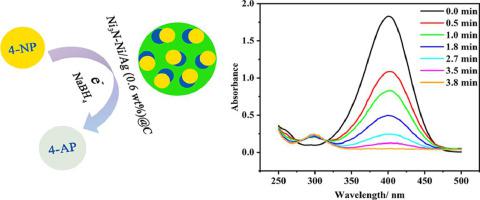Journal of the Taiwan Institute of Chemical Engineers ( IF 5.5 ) Pub Date : 2023-01-21 , DOI: 10.1016/j.jtice.2023.104708 Siya Ye , Huangruoyin Yang , Kanwal Iqbal , Yue Wu , Lin Tan , Haiyuan Hu , Xiaohui Xu , Weichun Ye

|
Background
Catalytic reduction of 4-nitrophenol (4-NP) to 4-aminophenol (4-AP) is a recurrent topic. The most promising catalysts are often regarded as noble metals. But maintaining high catalytic performance while reducing the number of noble metals remains a significant difficulty. Here, a 0.6 weight percent (wt%) Ag-based catalyst was used to catalyze the reduction of 4-NP in contaminated water.
Methods
Using a one-step urea-glass method and annealing at 380 °C, Ni3N-Ni heterostructures were implanted in a carbon matrix, and subsequently Ag nanoparticles were introduced to the Ni3N-Ni@C by galvanically substituting Ni for AgNO3. Spectra in the UV-vis range were employed to track the reduction reaction. Investigations were done into how both inorganic and organic species affected catalytic effectiveness.
Significant Results
Compared to Ni3N-Ni@C and Ni/Ag (0.6 wt%)@C, Ni3N-Ni/Ag (0.6 wt%)@C displayed good catalytic activity and stability toward 4-NP reduction with a rate constant of 8.1 × 103 s−1 g−1Ag. The catalytic efficiency was essentially unaffected by the interferents. The catalyst could quickly purify lake water that was contaminated with very concentrated 4-NP (140 ppm) in about 6 min.
中文翻译:

用于还原 4-硝基苯酚的低银含量 Ni3N-Ni/Ag@C 催化剂
背景
将 4-硝基苯酚 (4-NP) 催化还原为 4-氨基苯酚 (4-AP) 是一个反复出现的话题。最有前途的催化剂通常被认为是贵金属。但是在减少贵金属数量的同时保持高催化性能仍然是一个很大的困难。在这里,0.6 重量百分比 (wt%) 的 Ag 基催化剂用于催化受污染水中 4-NP 的还原。
方法
使用一步尿素玻璃法并在 380 °C 下退火,将 Ni 3 N-Ni 异质结构植入碳基体中,随后通过用 Ni 代替 AgNO将 Ag 纳米粒子引入 Ni 3 N-Ni@C 3 . 紫外-可见范围内的光谱被用来追踪还原反应。对无机和有机物种如何影响催化效率进行了调查。
显著成果
与 Ni 3 N-Ni@C 和 Ni/Ag (0.6 wt%)@C 相比,Ni 3 N-Ni/Ag (0.6 wt%)@C 显示出良好的催化活性和对 4-NP 还原的稳定性,速率常数8.1 × 10 3 s −1 g −1 Ag。催化效率基本上不受干扰物的影响。该催化剂可以在大约 6 分钟内快速净化被非常浓缩的 4-NP (140 ppm) 污染的湖水。































 京公网安备 11010802027423号
京公网安备 11010802027423号